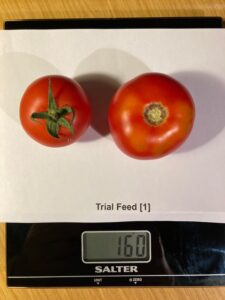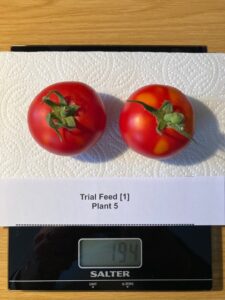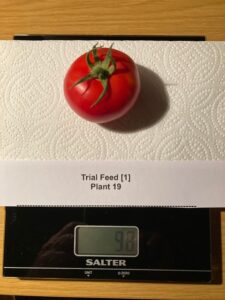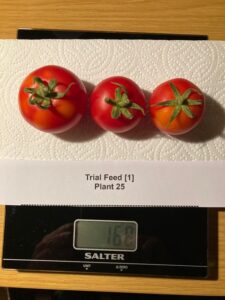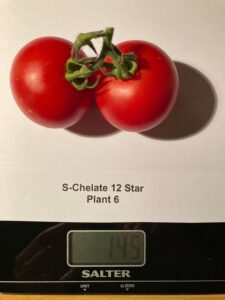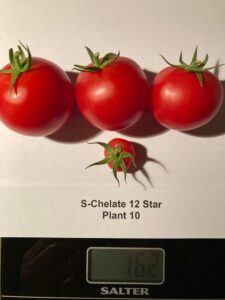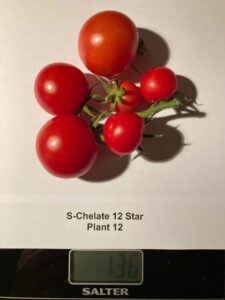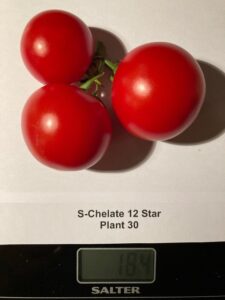Summary
Blossom end rot (BER) has been experienced growing tomatoes in extreme conditions using S-Chelate 12 Star by a small number of growers. To address this we decided to develop a more BER resistant feed.
Six trial feed formulations were produced and screened before selecting two for controlled trials in a Rothamsted Research glasshouse.
Both trial feeds produced high quality tomatoes with zero blossom end rot. The best formulation will be launched as our new specialist tomato feed, S-Chelate Protom.
S-Chelate 12 Star produced the highest yield of top quality tomatoes but with a small number of fruit being affected by blossom end rot.
The competitor’s feed used in the trial produced a lower yield and a small number of BER affected fruit.
All four feeds produced great tasting tomatoes.
Conclusion
We will introduce the best feed as S-Chelate Protom, a specialist tomato feed suited to:
- Soft water areas,
- Rain water users
- High temperature growing in greenhouses
- Blossom End Rot prone tomato varieties.
We will continue to promote S-Chelate 12 Star for high yields in all other tomato and plant growing to:
- Hard water users.
- Garden and allotment growers
- Blossom End Rot resistant tomato varieties
Trial Conditions
Blossom end rot is caused by a deficiency of calcium in the fruits. This can be caused by irregular watering affecting the plant’s transport mechanism or by a lack of calcium in the growing medium. Incorrect balancing of fertiliser can affect the plant’s ability to take up calcium from the growing medium. Soft tap water and rainwater are both low in Calcium.
Hot weather with bright sunlight produces very high growth rates, particularly in greenhouses.
If this is not sufficiently compensated for by additional feeding and / or watering this can prevent the plant absorbing enough calcium from the growing medium. This will then cause blossom end rot.
Our trial protocol was, therefore, aimed at providing all of the nutrition from the feed, minimising nutrients from the water and the growing medium in order to really test the feed with as little supplementary nutrient sources as possible.
We used:
- Deionised water – pure water with no Calcium or other mineral content – like rain water.
- Natural Coir – coconut coir with no added nutrients, a peat free growing medium.
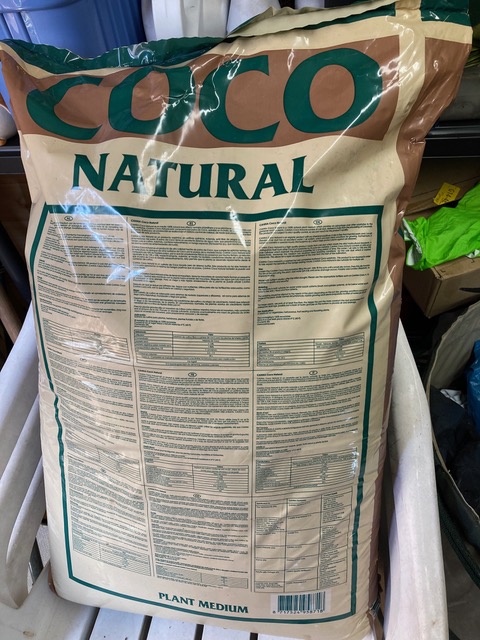
Canna Coir as Used for Trial
A 2-3cm water absorbent conduit layer of Biohome* – these are sterile, reusable, porous glass beads, was placed at the base of the pots. The glass beads also acted as a high density ballast to help keep the pots upright as the plants grew. Coir was then placed above to fill the pots.
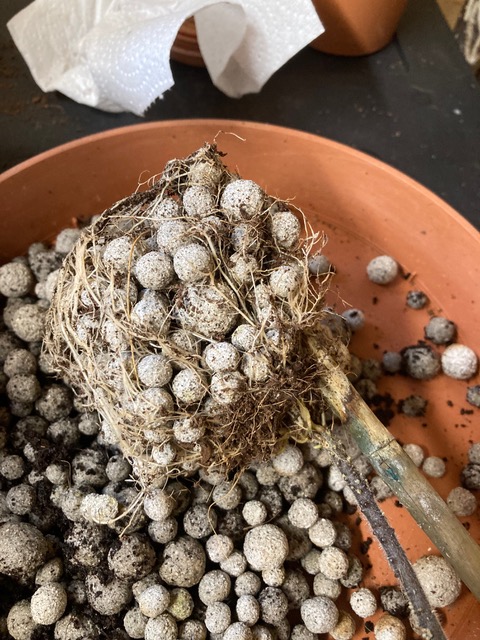
Biohome Porous glass beads with root system
Therefore all of the nutrition was provided by the feeds.
In order to conduct meaningful trials, the growing conditions need to be as controlled as far as possible to minimise the variability from the weather specifically temperature and light levels. Rothamsted Research** heated greenhouses provide tightly controlled conditions using natural heat and light supplemented by artificial lighting and heat when temperature and light levels drop below their optimum and were used for this trial.
The tomato variety was blight resistant Crimson Crush F1 grown from seeds. Use of an F1 hybrid minimised the chances of genetic variability in the plants.
Tomato plants were grown from the seeds in indoor conditions and taken to Rothamsted so that 8 of each grown, using the 4 feeds could be potted up.
Feeds were applied when pots were dry until feed water could be seen coming through into the saucers.
The plants were grown from seeds planted on the 4th May 2023 in wick fed seed trays.
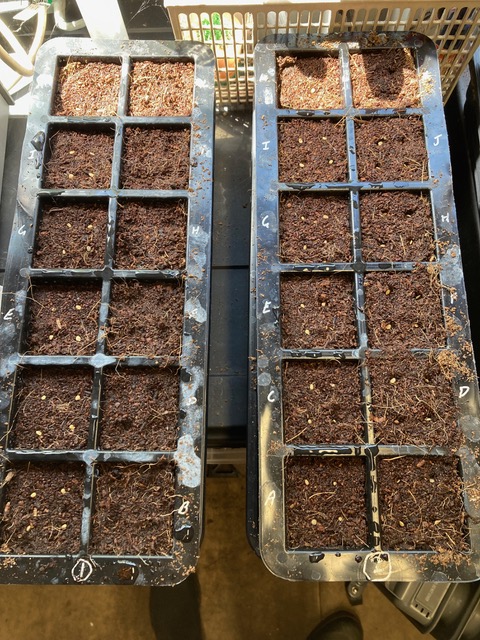
Seeds planted in trays 4th May 2023
Plants were grown mainly indoors though some outdoors in ambient conditions until 17th July 2023 when they all were transferred to the Rothamsted controlled environment glasshouse. The trial was terminated on 1st November 2023.
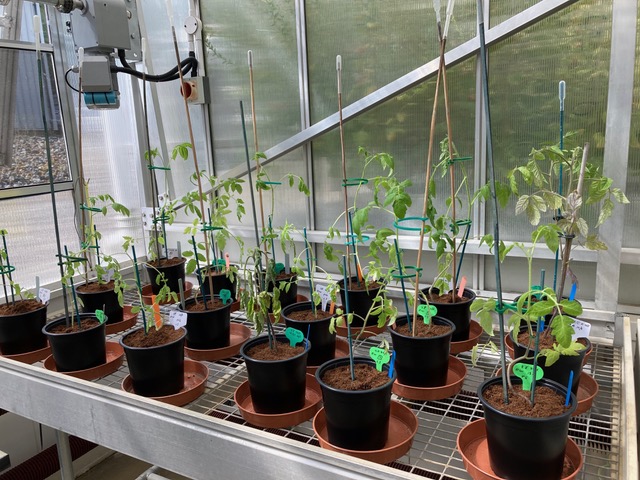
Plants on day 73 – 17th July 2023 – Potted up for trial at Rothamsted
The plants were assessed and photographed every two weeks. When tomatoes grew and were ripe, they were inspected for blossom end rot, picked, weighed and photographed to measure yields.
Feeds
S-Chelate Protom – originally Trial Feed [1]
High Nitrogen, Phosphorus and Potassium plus a new S-Chelate Calcium source, low levels of supplementary S-Chelate Micronutrients
One part product applied at a rate of 0.9 x 5g scoop to 4.5 litres water
S-Chelate 12 Star
High Potassium plus established S-Chelate Calcium source, high levels of S-Chelate Micronutrients
One part product
2 x 5g scoops to 4.5litres of water
Well-known Competitor’s Feed
High Potassium and non-chelated Calcium, conventionally chelated micronutrients.
Two part product – 0.6 x 5g scoop part A to 2.25 litres of water, 0.6 x 5g scoop part B to 2.25 litres of water then mix both solutions together
Trial feed [4]
High Potassium and non-chelated Calcium, high levels of S-Chelate Micro and Secondary nutrients.
One part product applied at a rate of 1.2 x 5g scoop to 4.5 litres of water
Please see Excel tables and graphs for details:
Blossom End Rot Tomato Trial Yields – 5th Nov 2023 – Click to Download
Blossom End Rot Tomato Trial Feeds Elemental Breakdown – 24th April 2024 – PDF Click to Download
Results
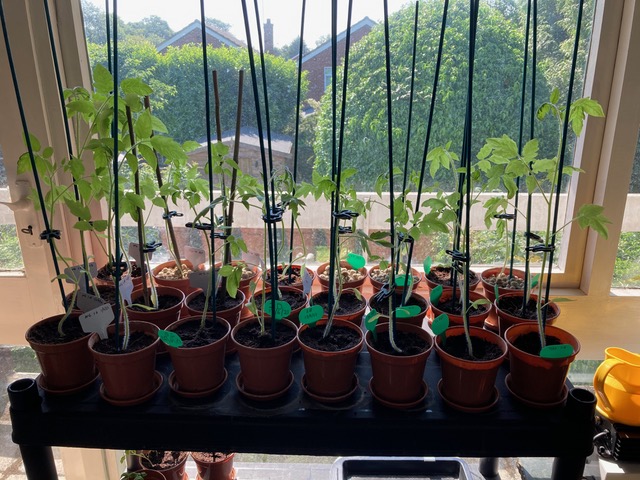
Day 40 – Plants potted up from trays
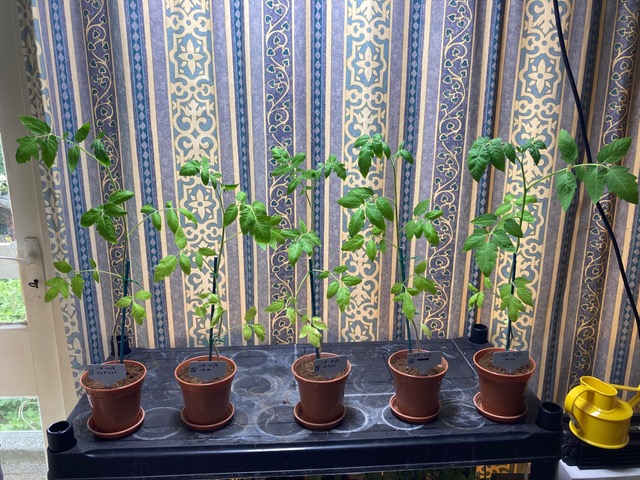
Day 67 – Feed [1] plants pulling away
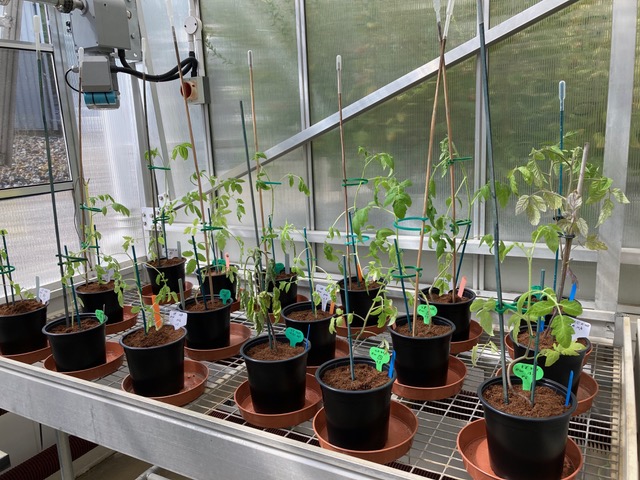
Day 73 – First day at Rothamsted Glasshouse
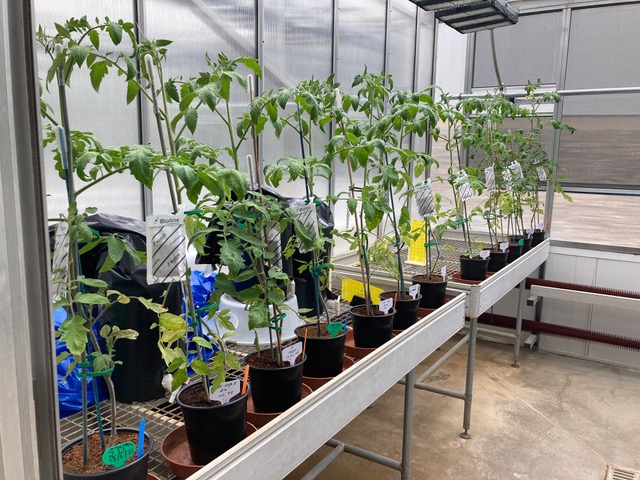
Day 89 – Plants in order of size
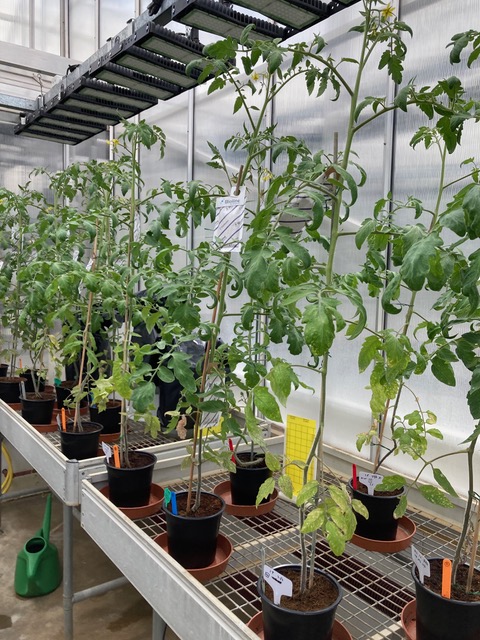
Day 103 – Plants numbered
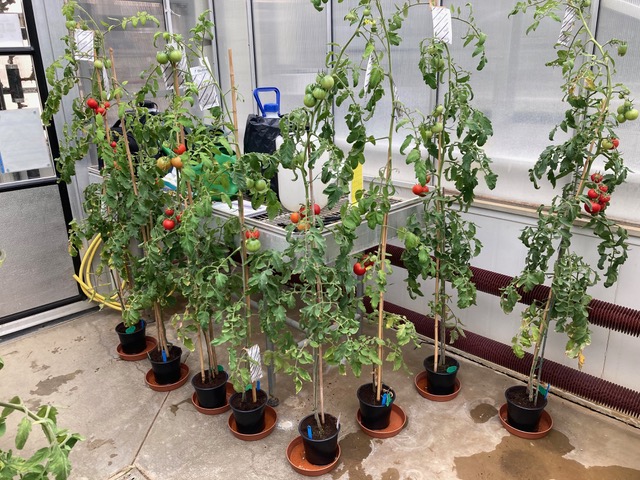
Day 152 – S-Chelate 12 Star Plants
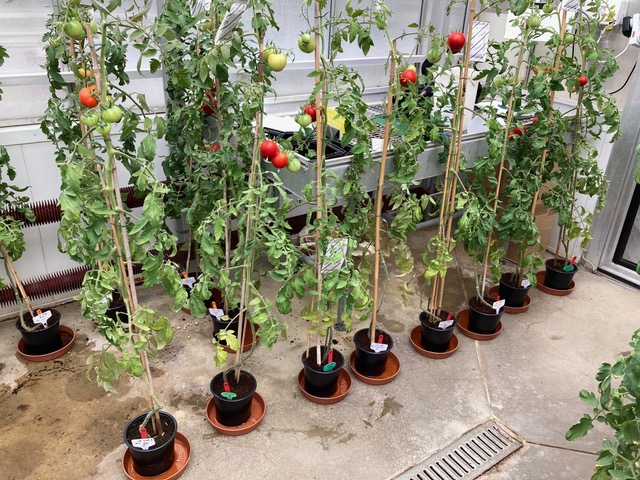
Day 152 – Feed [1] Plants
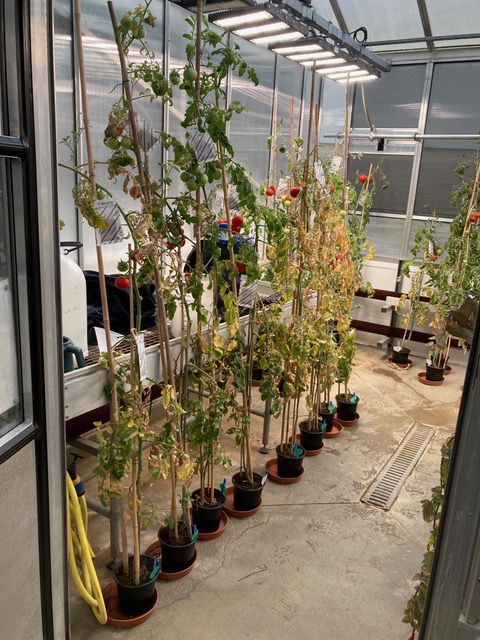
Day 180 – End of Trial– S-Chelate 12 Star Plants
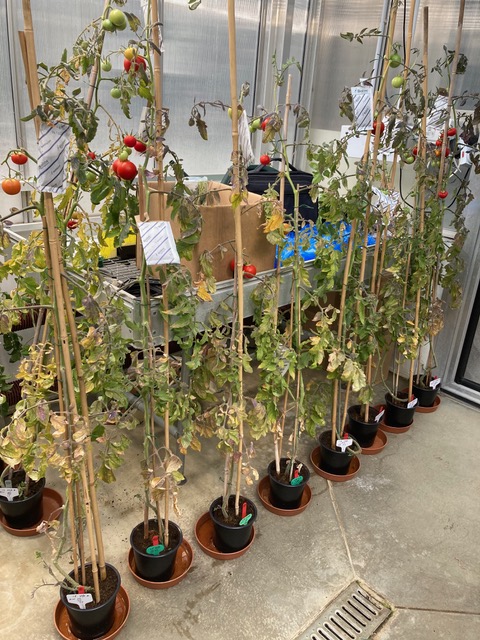
13) Photo of plants at Rothamsted – 1st Nov 2023 – 3047
Day 180 – End of Trial – Feed [1] Plants
Both trial feeds gave good yields and showed no blossom end rot at all.
Trial feed [1] is being launched as S-Chelate Protom. It is a high performance, high nitrogen feed which only needs one 5ml scoop per 4.5 litres of water.
S-Chelate 12 Star produced by far the highest yield despite showing BER in a small number of fruits.
Trial feed 4 calcium source was not viable for a one part feed.
Competitor’s feed produced a good yield and some BER
All feeds produced high quality, really great tasting tomatoes.
Conclusion
We will introduce the best feed as S-Chelate Protom, a specialist tomato feed suited to:
- Soft water areas,
- Rain water users
- High temperature growing in greenhouses
- Blossom End Rot prone tomato varieties.
We will continue to promote S-Chelate 12 Star for high yields in all other tomato and plant growing to:
- Hard water users.
- Garden and allotment growers
- Blossom End Rot resistant tomato varieties
* https://biohomefiltermedia.co.uk
** https://www.rothamsted.ac.uk
S-Chelate and S-Chelate Plant Nutrition are brands of Align Chemical Ltd
Align Chemical Limited, Registered in England and Wales, no 6335052
Registered Office: 29 Milton Lawns, Amersham, Bucks, HP6 6BJ
UK VAT registration number: 913 4463 37


